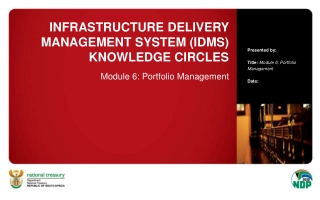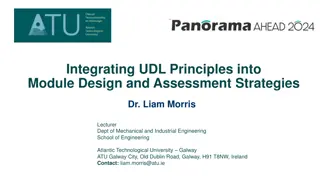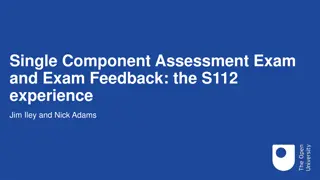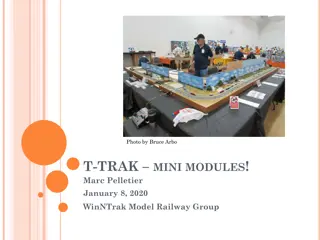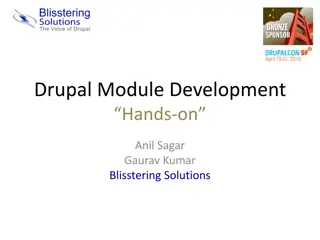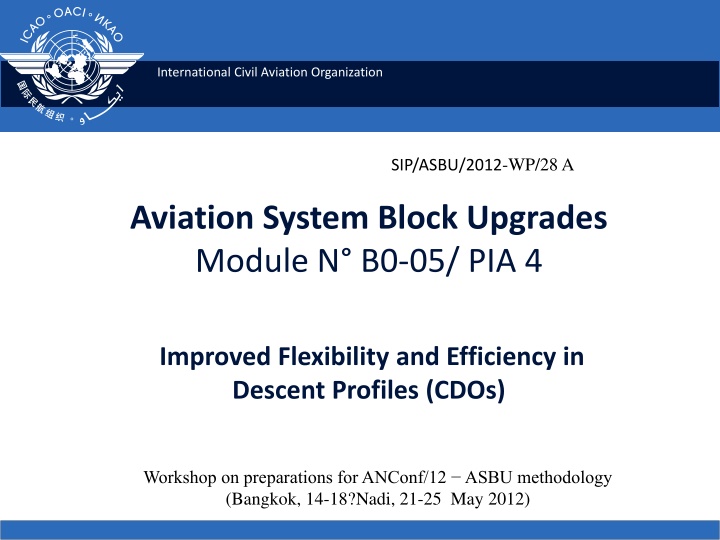
Improved Flexibility and Efficiency in Descent Profiles - ASBU Workshop Summary
Learn about the deployment of performance-based airspace and arrival procedures for continuous descent operations, the impact on cost-effectiveness, efficiency, and predictability in aviation systems. Explore the benefits of Continuous Descent Operations (CDOs) for optimized flight profiles and reduced emissions, as discussed in the ASBU methodology workshop.
Download Presentation

Please find below an Image/Link to download the presentation.
The content on the website is provided AS IS for your information and personal use only. It may not be sold, licensed, or shared on other websites without obtaining consent from the author. If you encounter any issues during the download, it is possible that the publisher has removed the file from their server.
You are allowed to download the files provided on this website for personal or commercial use, subject to the condition that they are used lawfully. All files are the property of their respective owners.
The content on the website is provided AS IS for your information and personal use only. It may not be sold, licensed, or shared on other websites without obtaining consent from the author.
E N D
Presentation Transcript
International Civil Aviation Organization SIP/ASBU/2012-WP/28 A Aviation System Block Upgrades Module N B0-05/ PIA 4 Improved Flexibility and Efficiency in Descent Profiles (CDOs) Workshop on preparations for ANConf/12 ASBU methodology (Bangkok, 14-18?Nadi, 21-25 May 2012)
Module N B0-05 Improved Flexibility and Efficiency in Descent Profiles (CDOs) Summary Deployment of performance-based airspace and arrival procedures that allow aircrafts to fly their optimum profile taking account airspace and traffic complexity with continuous descent operations (CDOs). Main Performance Impact KPA-03 Cost-effectiveness; KPA-04 Efficiency; KPA-09 - Predictability Approach/Arrivals and En-Route. Operating Environment/Phases of Flight Global Concept Component(s) AOM Airspace Organisation and Management AO Aerodrome Operations TS Traffic Synchronisation, AOM GPI-10- Terminal Area Design and Management; Global Plan Initiatives (GPI) GPI-11- RNP and RNAV Standard instrument Departures (SIDS)and Standard Terminal Arrivals (STARS); NIL Pre-Requisites Global Readiness Checklist Status Standards Readiness Avionics Availability Ground System Availability Procedures Available Operations Approvals Ready Ready Ready Ready Ready ICAO SIP 2012-ASBU Workshop. Block Upgrades N B0-05 2
Module N B0-05 - Baseline Varies from one State/region to the next. Some aspects of the movement to PBN have already been subject of local improvements in areas ICAO SIP 2012-ASBU Workshop.Block Upgrades N B0-05 3
Module N B0-05 Change brought by the Module Element 1 Continuous Descent Operations (CDO) CDO is enabled by airspace design, procedure design and facilitation by ATC An optimum CDO starts from the top-of-descent (TOD) and uses descent profiles that reduce controller-pilot communications and segments of level flight. Ex: an arriving aircraft descends continuously, to the greatest possible extent, by employing minimum engine thrust, ideally in a low drag configuration, prior to the final approach fix/final approach point (FAF/FAP). Element 2 Performance -based Navigation (PBN) The PBN concept encompasses two types of navigation specifications: RNAV specification: navigation specification based on area navigation that does not include the requirement for on-board performance monitoring and alerting, designated by the prefix RNAV, RNP specification: navigation specification based on area navigation that includes the requirement for on-board performance monitoring and alerting, designated by the prefix RNP, ex: PBN STARs ICAO SIP 2012-ASBU Workshop.Block Upgrades N B0-05 4
Module N B0-05 Intended Performance Operational Improvement cost savings through reduced fuel burn authorization of operations where noise limitations would otherwise result in operations being curtailed or restricted reduction in the number of required radio transmissions optimal management of the top-of-descent in the en-route airspace Efficiency Environment Reduction on CO2 through reduced fuel burn more consistent flight paths and stabilized approach paths reduction in the incidence of controlled flight into terrain (CFIT) separation with the surrounding traffic (especially free-routing) reduction in the number of conflicts. Safety CDO benefits are heavily dependent on each specific ATM environment; If implemented within the ICAO CDO manual framework, it is envisaged that the benefit/cost ratio (BCR) will be positive. The advantage of PBN to the ANSP is that PBN avoids the need to purchase and deploy navigation aids for each new route or instrument procedure. CBA ICAO SIP 2012-ASBU Workshop.Block Upgrades N B0-05 5
Module N B0-05 Necessary Procedures (Air & Ground) ICAO Continuous Descent Operations (CDO) Manual (Document 9931) Provides guidance on the airspace design, instrument flight procedures, ATC facilitation and flight techniques necessary to enable continuous descent profiles. ICAO Performance-based Navigation Manual (ICAO Document 9613) Provides general guidance on PBN implementation. ICAO PBN operational approval guidance material will be available by June 2012 ICAO SIP 2012-ASBU Workshop.Block Upgrades N B0-05 6
Module N B0-05 Necessary System Capability Avionics CDO is an aircraft operating technique aided by appropriate airspace and procedure design and appropriate ATC clearances enabling the execution of a flight profile optimized to the operating capability of the aircraft. CDO can be flown with or without support of a computer-generated vertical flight path (i.e. the vertical navigation (VNAV) (FMS)) and with or without a fixed lateral path This is most readily determined by the onboard FMS Ground Systems PBN requirements will be affected by the CNS and ATM environments Performance requirements depend on what reversionary, non-RNAV means of navigation are available and what degree of redundancy is required to ensure adequate continuity of functions RNP AR Approaches requires significant investment, ANSPs should work closely with airlines ICAO SIP 2012-ASBU Workshop.Block Upgrades N B0-05 7
Module N B0-05 Training and Qualification Requirements Since RNP AR Approaches also require significant training, ANSPs should work closely with airlines to determine where RNP AR Approach should be implemented Training in the operational standards and procedures are required for this module Likewise, the qualifications requirements are identified in the regulatory requirements ICAO SIP 2012-ASBU Workshop.Block Upgrades N B0-05 8
Module N B0-05 Regulatory/standardization needs and Approval Plan (Air and Ground) Regulatory/Standardization: Use current published requirements Approval Plans: Must be in accordance with application requirements e.g. airspace design, air traffic operations, PBN requirements for fixed radius transitions, radius-to-fix legs, Required Time of Arrival (RTA), parallel offset, etc ICAO SIP 2012-ASBU Workshop.Block Upgrades N B0-05 9
Module N B0-05 Reference Documents Standards For flight plan requirements in Amendment 1, ICAO Document 4444; PANS/ATM v15 Procedures Guidance Material ICAO Doc 9613, Performance-based Navigation (PBN) Manual; ICAO Doc 9931, Continuous Descent Operations (CDO) Manual;. FAA Advisory Circular, AC 90-105, Approval Guidance for RNP Operations and Barometric Vertical Navigation in the U.S. National Airspace System) which provides system and operational approval guidance for operators (only reflects the US situation). Approval Documents ICAO Doc 9931, Continuous Descent Operations Manual; ICAO Doc 9613, Performance Based Navigation Manual; FAA AC120-108, CDFA. ICAO SIP 2012-ASBU Workshop.Block Upgrades N B0-05 10
Module N B0-05 Implementation - Benefits and Elements Improved Flexibility and Efficiency in Descent Profiles (CDOs) Benefits: Efficiency, Environment and Safety Elements: CDO and PBN STARs No avionics or Ground systems required To be reflected in ANRF ICAO SIP 2012-ASBU Workshop. Block Upgrades N B0-05 11


